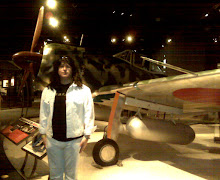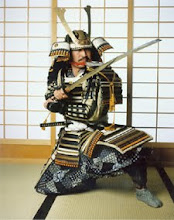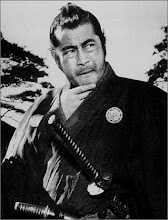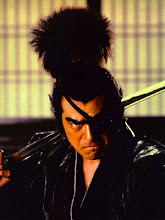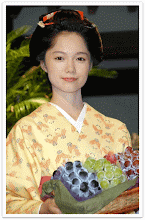One can never underestimate the power and majesty opera can have on one’s senses. As clearly demonstrated with last year’s visually stunning Noh Theater performance at the Aratani Theater in Little Tokyo - Los Angeles, language barriers or lack of spoken language proves to be no barrier at all when it comes to Kabuki. Performances here in the United States are rare and not to be missed and last night was no exception. The Shochiku Company came to the renowned Aratani Theater in Little Tokyo to perform two sold out performances of this most rare and exquisite art.
In 2005 I had the unique pleasure of seeing the Shochiku Company’s performance of The Grand Kabuki featuring national treasure actor Nakamura Ganjiro III in a performance of Chikamatsu-za’s The Love Suicides. There, I had seen something that had exceeded my own expectations as demonstrated during the show’s tearful finale. But last night’s presentation was quite different. Now after seeing The Grand Kabuki you have to wonder, well how can you top that? Honestly, there is no way you can make such comparisons. All one can do is behold and allow onself to be captivated by the magic that is Kabuki.
As true to it’s advertising, the event was truly a behind the scenes look at how Kabuki is put together. Now I have seen many films from Japan showing the makeup process but never have we seen anything on the other elements involved. We were treated to an introductory lecture from the lead actor Matanosuke Nakamura who explained how the various instruments are played and how they are used to provide to the overall imagery. Such as for example the sound of snow falling with the use of a large Taiko drum or the use of flute and shamiesen. This presented a greater understanding to Kabuki that had I seen this lecture would have made the 2005 tour even deeper for me. What we bore witness to in 2009 was far different from the 2005 tour and yet equally entertaining.
But it didn’t stop there. We were treated to a live on stage demonstration of how makeup is applied complete with all it's symbolism explained in intricate detail. The wardrobe demonstration provided us with a glimpse of how the actors embody the soul of their characters. It was truly fascinating to see so many key elements come together before our very eyes and there were still there were performances to behold.
When I watched the Grand Kabuki in 2005 I was treated to a comedy and a tragedy. This year’s presentation offered us something completely different yet equally dramatic. The first performance was Sagi Musume (Heron Maiden) that was first performed in 1782. This was a solo performance of a maiden who dances on a frozen pond in what was billed as “A play of unrequited love.” This involved the actor demonstrating the various female poses and gestures while the effects of snow petals fell from the ceiling while the Taiko drum dazzled our auditory senses. The actor would go through several costume changes on stage characterized as transformations of torments and pleads of pity. It was visually stunning as it was dramatic.

I was truly mesmerized by Sagi Musume but the show did not end there. As with the earlier Kabuki there would be a fifteen minute intermission followed by another lecture this time involving the mechanics of the stage hands and how contribute both on stage as well as behind the scenes.
The performance that followed was Shakkyo (The Stone Bridge). This was the famous Lion Dance I had seen in documentaries about Kabuki which reminded me of Noh Theater in its elaborate character design. This dance based on an ancient Buddhist fable featured both male and female lions with their large elaborate colored wigs. White for male and red for female. This featured shishi (soul stirring) and Keburi (swinging of long hair) – One can honestly say SUGOII NE'!
I can not say when we will be fortunate enough to see another Kabuki performance here in Little Tokyo but what I can say is if you get the rare opportunity to see a Kabuki performance outside of Japan, Do not miss it! It was an incredible night out and good to see so many people dressed in elaborate kimono especially the few Americans in Kimono at this very special sold out performance. I love seeing other Americans who appreciate Japanese culture as much as I do. It was good to even run into a fellow Shinkendoka James Huang at the performance as well as meet Miyuki Sohara -the director of the new Geisha Documentary HANNARI. I would like to thank the JACCC, The Consul General of Japan, and the Shochiku company for both enlightening us as well as culturally enriching us with this most rare and beautiful art.
Domo Arigatou' Gozaimasu!
*L*
 It had been well over a month since the new statue of Kobo Daishi had made it's appearence at the front entrance of the Koyasan Buddist Temple located in the heart of Little Tokyo. It was a generous gift to the temple which had long served the Japanese-American Community since just before the outbreak of war in 1941. After some careful planning, the dedication took place this month before the monthly Goma Fire Ritual.
It had been well over a month since the new statue of Kobo Daishi had made it's appearence at the front entrance of the Koyasan Buddist Temple located in the heart of Little Tokyo. It was a generous gift to the temple which had long served the Japanese-American Community since just before the outbreak of war in 1941. After some careful planning, the dedication took place this month before the monthly Goma Fire Ritual. 






